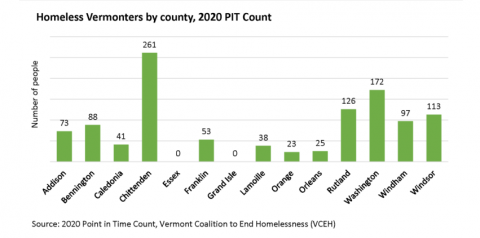Point in Time Count for 2020 shows slight increase in number of homeless

Posted by Mia Watson on Monday, June 15, 2020 - 8:55am
Newly released data from the 2020 Point-in-Time Count in January found 1,110 people experiencing homelessness in Vermont, a slight increase from the prior year. That number has increased to over 2,000 people during the COVID-19 pandemic, according to the Vermont Coalition to End Homelessness.
The Point-in-Time (PIT) Count was conducted on January 22 by the Vermont Coalition to End Homelessness and the Chittenden County Homeless Alliance. The annual survey attempts to count homeless individuals and families, including people in shelters, transitional housing, hotel rooms purchased using public funding or living outdoors. It does not count those at risk of homelessness or temporarily living with friends or family. Although the PIT count is the one of the best sources available, it inevitably underrepresents the total extent of homelessness in our state throughout the entire year.
Many of indicators of homelessness showed little change between 2019 and 2020. 1,110 Vermonters experienced homelessness compared to 1,089 in 2019. The number of homeless families, unsheltered people and chronically homeless people also increased slightly. There were some signs for optimism, such as decreases in the number of homeless children, veterans and households fleeing domestic violence. Chittenden County, which has the state’s largest homeless population, had a 16% decrease in the number of homeless individuals.
The extent to which the COVID-19 pandemic will impact homelessness in Vermont is not yet fully known, as the PIT count was conducted before the outbreak reach the state. Vermont’s government officials and nonprofits acted swiftly at the beginning of the crisis to move homeless Vermonters off streets and out of congregate shelters into hotels, camp sites and vacant apartments. As of May, an estimated 1,721 individuals and 355 people in families were housed at these sites. The state and Legislature are working on a more permanent housing solution.
Despite the best efforts of Vermont officials and nonprofits, Vermont faces many challenges as it begins the recovery from the pandemic. Although weekly unemployment numbers are beginning to decline, they remain at historic high levels, and are projected to persist for years. Homelessness has typically increased during past recessions as people struggle to pay rent and mortgages. Although Vermont has enacted an eviction moratorium, it will only stay in place until 30 days after Vermont’s State of Emergency ends.
Permanently ending homelessness in Vermont will require increased investment in new affordable apartments or rental vouchers, as well as social services to support vulnerable, high-needs households.

